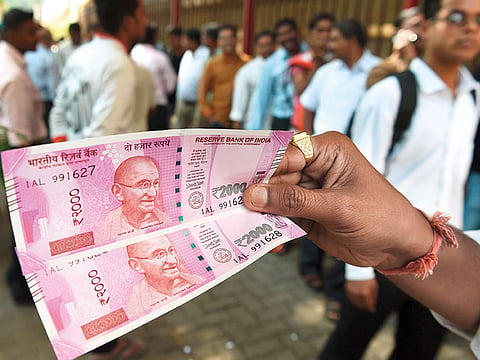Demonetisation’s impact on India’s economic growth outlook to linger longer
Moving goalposts to new targets remains unconvincing

Dubai: One year since India’s demonetisation that saw the immediate cancellation of all 500 and 1,000 denomination rupee notes that accounted for 86 per cent of currency in circulation, India’s mainstream media, political parties, economists and financial experts are still debating if the move actually achieved its original goals.
The sudden move by India’s Prime Minister, Narendra Modi, on November 8, 2016 was intended to be a surprise tactic to catch the black market and tackle issues like black money, terror funding and counterfeit currency.
While most economists, analysts, business fraternity and the ordinary folks did not have issues with the intentions of the government, when it came to the actual implementation, the government machinery and the banking system could not cope with the panic rush for cash. What ensued was several months of confusion and disruption that hurt businesses and consumers alike.
Of course, following several months of disruption, the government and the Reserve Bank of India (RBI) have not come up with any kind of quantification on what demonetisation achieved in terms of original objectives. On the contrary, the RBI has revealed that almost all the money that was withdrawn has come back into the system, which means that households still prefer to hold cash, and the phantom of black money continues to elude the tax net. The government has revealed that the number of taxpayers has increased, but the hard numbers are still missing.
When the unintended consequences of the demonetisation began to sink in, there have been attempts by the authorities to move the goalposts to other new targets such as digitising the economy to creation of more accountability and better audit trail for businesses.
Clearly, the surprise move didn’t go as smoothly as planned and many wondered if there was a plan at all to address the massive confusion that followed the withdrawal of more than 86 per cent of currency in circulation at such a short notice. Banks and ATMs could not handle the serpentine queues for several weeks.
As ordinary folks tried to switch their old money with new, shortage of currency saw every aspect of life getting impacted with businesses shutting doors, to employers unable to pay their employees and suppliers, people unable to pay for travel, hospital bills, school fees or any economic transaction that involved money.
The disruption came with a massive cost in terms of a general slowdown in India’s GDP growth. The International Monetary Fund (IMF) in October slashed India’s GDP growth forecast for the 2017-18 financial year to 6.7 per cent in its World Economic Outlook report. In its April and July reports, the IMF had predicted that India would grow at 7.2 per cent in 2017-18.
The IMF has reduced the projected GDP growth rate for 2018-19 from 7.7 per cent to 7.4 per cent.
“In India, growth momentum slowed, reflecting the lingering impact of the authorities’ currency exchange initiative [demonetisation] as well as uncertainty related to the midyear introduction of the countrywide Goods and Service Tax,” the IMF said in its October report. India’s GDP growth rate fell to 5.7 per cent for the first quarter of 2017-18.
The RBI has revealed that almost all the money that was withdrawn has come back into the system, which means that households still prefer to hold cash.”
In its South Asia Economic Focus (Fall 2017), the World Bank reduced India’s GDP growth forecast to 7 per cent for 2017-18 from 7.2 per cent estimated earlier, blaming disruptions caused by demonetisation and the implementation of the GST, while maintaining at the same time that the economy would claw back to grow at 7.4 per cent by 2019-20.
Both the Asian Development Bank and the Organisation for Economic Cooperation and Development (OECD) have also cut their growth projections for India to 7 per cent and 6.7 per cent, respectively, for fiscal 2017-18.
The World Bank said the unexpected slowdown in India’s growth story is because of the delayed consequence of demonetisation, sharp decline in the growth rate of public expenditures and uncertainty created by the introduction of GST.
The multilateral lending agency said that because the main explanations offered for the slowdown of the last quarter refer to temporary shocks, the growth rate could be expected to bounce back.
Sign up for the Daily Briefing
Get the latest news and updates straight to your inbox


